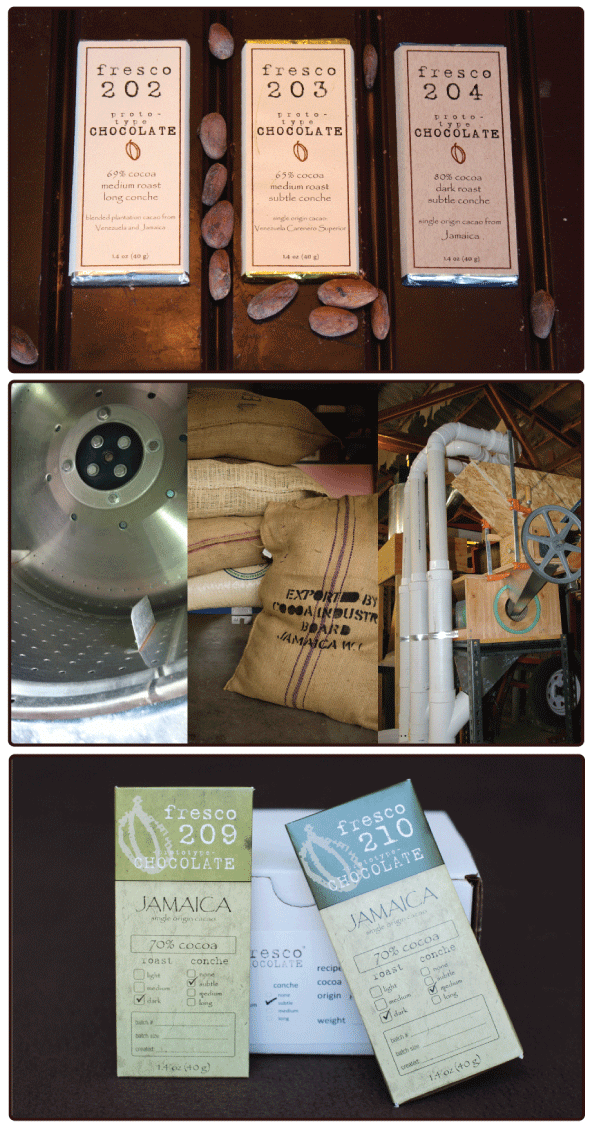 This response we hear from Rob Anderson. Rob is founder & craft chocolate maker at award-winning Fresco Chocolate. Fresco produces origin bars that include information on roast and conche times. Here’s what he told us:
This response we hear from Rob Anderson. Rob is founder & craft chocolate maker at award-winning Fresco Chocolate. Fresco produces origin bars that include information on roast and conche times. Here’s what he told us:
We had no idea what to expect when 430 pounds of Jamaican cocoa arrived on that March day in 2004. Our first experience a few months earlier with a single bag of Venezuelan Carenero Superior went better than expected. The Carenero tasted pretty good without any external heat. Those little stone grinders generate heat from friction and cause a limited amount of "self conching" effect, whether you want it or not. Because the Jamaican turned out so bad, we did some additional research into the chocolate making process. That's when we discovered that there were machines called conches, dedicated to mixing and heating chocolate to develop flavor. So we tried to force this flavor development to happen in our little grinder with a few heat lamps.
Equipped with a counter top rotisserie oven for roasting, a wheat grinder - shop vac creation for cracking and winnowing and a small spice grinder, we were making chocolate. The Carenero tasted pretty good after a day or so of grinding. The same approach was sure to work on the Jamaican beans. Then why were the most flattering descriptions of our Jamaican chocolate from our guinea pig tasters "lawn clippings" and "wet cigar"? Enter heat lamps stage left and our spice grinder doubled as a conche. Using the heat lamps, we tried mixing the chocolate at about 150 degrees (F) for about four hours. Our toxic Jamaican mess magically improved. If less if good, more is better, right? Heating the chocolate to 190-200 degrees (F) for 8 hours would be awesome. Other than grinder parts melting the results were favorable. We don't think the chocolate was contaminated but at the time we didn't know what we were doing. Who knows, we may have unknowingly cooked up a Jamaican-polymer blend. We then realized the existing equipment wasn't going to be sufficient for our chocolate experiments so we upgraded what we had by redesigning portions of the grinder to be more robust, allowing it to be operated at higher temperatures. After all, being Engineers, that's what we do. Eventually, our goals outpaced the equipment and we upgraded to larger equipment for each step in the chocolate making process. Some equipment we designed and made ourselves, other equipment we purchased.
The more important aspect of these early experiments was the realization that chocolate could be made with almost endless variations. We had recently discovered that cocoa bean roasting time and temperature were both important to chocolate flavor. Of course, the ratio of ingredients matter: cocoa, sugar, milk powder, vanilla, cocoa butter, lecithin and so on (on a side note we used Soy Lecithin in our first few batches of chocolate. We read somewhere that chocolate needed Lecithin so we added it. We realized this information was erroneous after a few more batches). During our conche experiment a couple of new variables hit main stage: bean origin and heating the chocolate to change the flavor - conching. Wow, this was getting complicated. How many permutations of chocolate recipes could there be? A quick calculation and I was completely overwhelmed: Even limiting the variability of each parameter results in a staggering number of potentially unique chocolate recipes. To illustrate, run a quick calculation with these limited variations: number of bean types = 10, different roast temperatures = 3, different roast durations = 5, different ingredients and ratios = 8 (stick with dark chocolate only for now), conche temperatures = 4, conche durations = 6. These limited parameters have the potential of producing over 28,000 different and unique chocolate recipes. I guess we better get started.
We analyzed the differences between the Venezuelan Carenero bean and the Jamaican that would explain why more heat was needed with the Jamaican. We found that the Jamaican beans had an off note that needed heat and time to eliminate. In those early days a "chocolate expert" told me that the Jamaican beans were no good and that I should throw them out. When we finally figured out that the Jamaican cocoa needed a longer conche time at a higher temperature the results turned from bad to pretty good. We haven't made this recipe since 2011 but several of the retail shops that carry our products still ask for it because of its unique flavor. This really highlight to me that there are many unique flavors hidden inside those little beans from around the world that are yet to be discovered.
Since that first bag of Venezuelan Carenero we've made just over 300 batches of chocolate. Some were good, others were pretty bad, but all were different. I tell this story to illustrate a point: everything matters. No two cocoa origins or harvests are the same, changing the cocoa roasting time or temperature effects all the steps down the line. Grinding and conching can be accomplished in many different ways, and on it goes. We have a motto that represents how we approach chocolate making, it goes like this: "exceptional chocolate is created through a series of events, change any one event and the outcome is a new creation". For chocolate makers the possible outcomes are endless. If you're just starting down this path or thinking about starting, be patient, learn something from every misstep, enjoy the ride and remember, everything matters.
